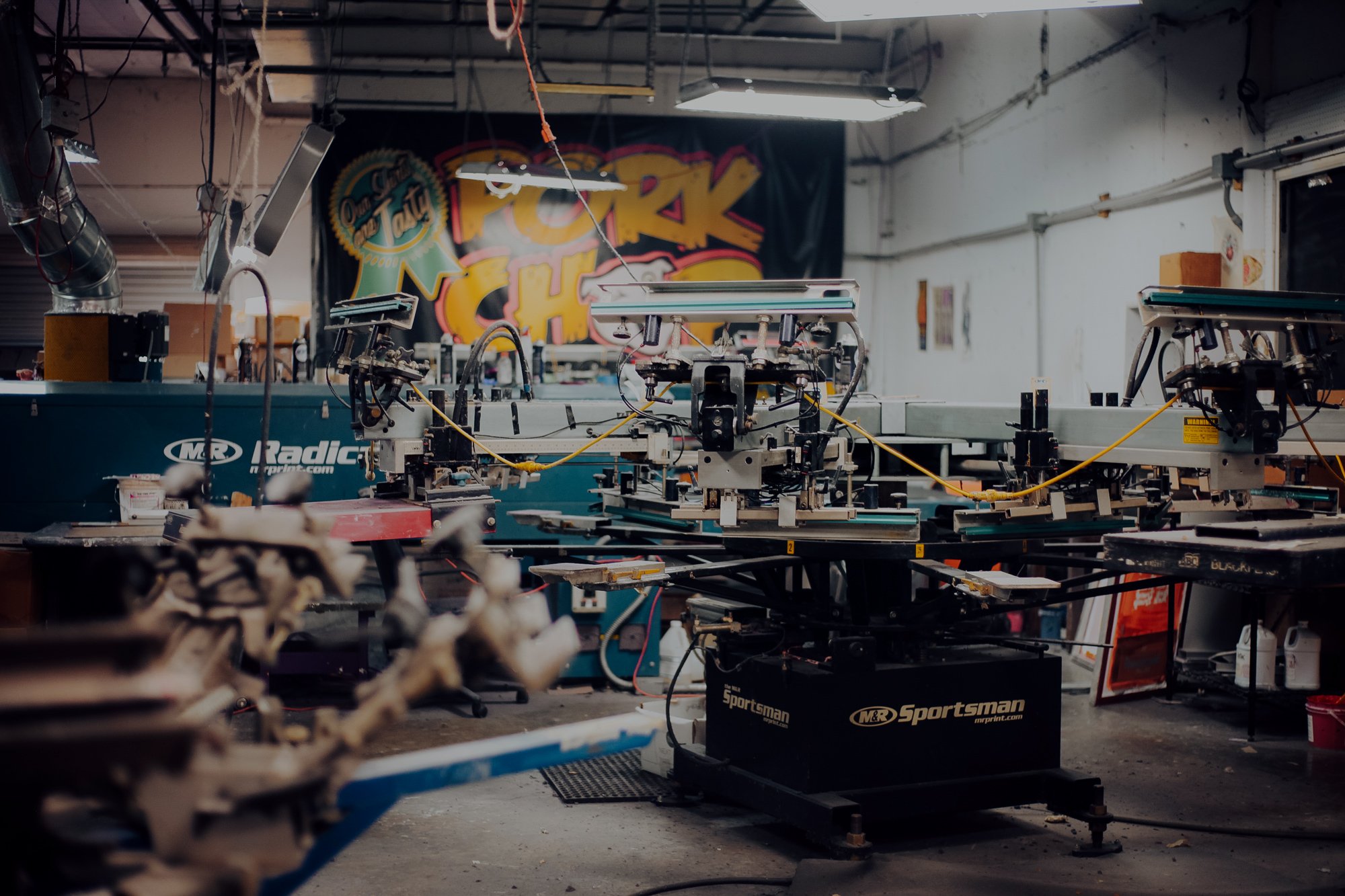Affordable Screen Printing Kit for Home Use
Wiki Article
Screen Printing Uncovered: Every Little Thing You Required to Know About Tee and Garment Printing Methods
If you have actually ever asked yourself just how those vibrant styles end up on your preferred t-shirts, you're in the ideal place. Screen printing is a remarkable technique that integrates art with method, providing endless possibilities for imagination. Recognizing the basics, from devices to ink selections, can considerably affect your outcomes. All set to check out the important aspects that make screen printing an art form? Allow's uncover the details that can boost your projects.
The Basics of Display Printing: Just How It Functions
When you plunge right into display printing, you'll uncover it's both an art and a scientific research. At its core, display printing entails developing a pattern, or screen, that permits ink to go through only in specific locations (screen printing kit). You start by picking your layout and preparing your display with a light-sensitive emulsion. As soon as you subject this solution to light, it solidifies, leaving your style as an adverse space.Following, you'll blend your inks and prepare your printing surface. Position the display over the textile, then use a squeegee to push ink via the display onto the garment. This process calls for accuracy, as you want clear, dynamic prints. After printing, you'll heal the ink with heat, ensuring it abides by the textile and lasts with cleans. Each action is essential, and mastering them will certainly elevate your display printing abilities, changing simple garments into unique, expressive items.
Sorts Of Display Printing Methods
When you grasp the basics of screen printing, it's time to discover the various methods that can boost your styles. One preferred technique is standard screen printing, where ink is pushed via a stenciled display. This strategy is wonderful for bold, vibrant shades. There's water-based ink printing, which supplies a softer feeling and is green, yet it requires a different technique to curing.An additional choice is plastisol printing, understood for its durability and vivid shades, making it a favored for numerous brands. Experiment with halftone printing to produce gradient effects and complex styles.
Necessary Equipment for Display Printing
To attain spectacular outcomes in display printing, having the ideal devices is fundamental. You'll require a strong screen printing framework, which holds the mesh that transfers your design onto the garment. Next, purchase high-grade squeegees; these are necessary for using ink equally throughout the display. You'll also need an excellent direct exposure device to create your screens, as well as a washout cubicle for cleansing them after use. A reputable heat resource, like a conveyor dryer or warmth press, is vital for treating your prints to assure durability. Do not neglect a correct workspace, equipped with tables and storage for your supplies. Protective gear, such as masks and handwear covers, will certainly keep you risk-free from chemicals and inks. With the right devices, you'll be well on your way to generating professional-quality prints.Choosing the Right Inks and Materials
When choosing inks and products for display printing, you need to take into consideration the kind of ink that functions finest for your job. Consider fabric compatibility to ensure your styles look wonderful and last long. Additionally, discover environment-friendly ink options to make your printing process more lasting.Sorts Of Display Inks
Selecting the appropriate screen ink is essential for attaining dynamic, sturdy prints that fulfill your project's needs. There are numerous types of display inks to analyze. Specialty inks, such as metal or glow-in-the-dark, can add distinct results to your styles.
Textile Compatibility Considerations
Recognizing textile compatibility is important for attaining high-quality display prints, particularly since different materials react distinctly to numerous inks. Always evaluate your inks on example textile to assure they stick correctly and preserve color integrity. In addition, keep in mind that fabric weight and structure can affect the last end result, so choosing the ideal ink and material combo is vital for your project's success.Eco-Friendly Ink Options
Environmentally friendly inks are ending up being a preferred choice for display printers who want to minimize their environmental influence while preserving high quality. When picking inks, take into consideration water-based inks, which are less dangerous and less complicated to cleanse up compared to standard solvents.Additionally, look for inks made from renewable sources, such as soy or vegetable-based options. By choosing the best inks and materials, you'll not only produce sensational designs but additionally add to a more lasting printing process. Make the button, and your prints will reflect your dedication to the setting!
Preparing Your Design for Screen Printing

File Format Demands
To guarantee your style looks vivid and sharp on fabric, you'll require to pay close attention to file format demands for screen printing. Start with vector documents like AI or EPS, as they can be scaled without losing top quality. If you make use of raster photos, select high-resolution files, such as TIFF or PNG, preferably at 300 DPI. Stay clear of utilizing JPEGs, as they can lose clarity when resized. Also, ensure your style has a clear history to stop undesirable white edges on your prints. Keep color modes in mind; CMYK is conventional for display printing, so convert your RGB develops accordingly - screen printing kit. By complying with these guidelines, you'll set your artwork up for a successful print.Shade Separation Methods
Color splitting up is a crucial action in preparing your style for screen printing, and understanding it can considerably enhance your print high quality. You'll need to damage your layout into specific shades, as each color needs a next separate display throughout printing. This precision not only ensures exact color representation but likewise improves the printing process.Resolution and Size
Accomplishing the best results in display printing starts with guaranteeing your design has the appropriate resolution and dimension. Preferably, your art work should go to the very least 300 DPI (dots per inch) for sharp, clear prints. If you utilize reduced resolution, your end product may look unprofessional and pixelated.When it pertains to dimension, consider the measurements of your print area. Style your artwork to match the last print dimension, ideally creating it in the actual measurements you'll be publishing. This way, you'll prevent any type of unforeseen scaling issues.
Always inspect your design in both vector and raster formats. Vector graphics can be scaled without shedding high quality, making them suitable for display printing. Preparing correctly will ensure your design looks outstanding on every garment!
Step-by-Step Screen Printing Refine
Display printing is a dynamic procedure that allows you to create lively layouts on numerous surfaces. To get started, you'll require a display, emulsion, and your selected ink.Put ink onto the screen and make use of a squeegee to push the ink via the pattern onto the fabric. Lift the screen thoroughly and allow the print dry. You've effectively display printed your layout.
Tips for Effective Display Printing Projects
While you're diving into your display printing tasks, remember that preparation is vital to success. Beginning by gathering all your materials-- inks, mops, garments, and displays. A tidy work space assists protect against unwanted errors, so clean up prior to you start.Next, validate your art work is high-resolution and correctly sized for your garment. Check your screen for proper exposure and tidy it completely to stay clear of smudges. When mixing your inks, follow the manufacturer's guidelines to attain the best uniformity.
During printing, apply even pressure with your squeegee for regular outcomes. Don't hurry; take your time to confirm each print satisfies your criteria. After printing, allow your garments dry entirely prior to taking care of or packaging them.
Finally, always keep a sample of your help future recommendation. This means, you can analyze your progression and enhance your techniques in time. Delighted printing!

Regularly Asked Inquiries
How Long Does It Take to Establish a Screen Printing Job?
Establishing a display printing job usually takes around thirty minutes to an hour. You'll prepare the displays, mix inks, and change the press. The moment differs based on complexity and experience, so stay arranged!Can I Print on Various Material Enters Making Use Of the Very Same Strategy?
Yes, you can publish on various textile kinds using the very same technique, however you'll need to readjust your inks and settings. Some fabrics soak up ink differently, so exploring warranties the most effective outcomes for each and every product.What Prevail Mistakes to Stay Clear Of in Display Printing?
When display printing, prevent typical blunders like utilizing the wrong ink, overlooking correct exposure times, or avoiding pre-press checks. Always test your arrangement and preserve clean displays to guarantee quality results each time.Just How Can I Effectively Clean and Keep My Screen Printing Equipment?
To appropriately clean and maintain your screen printing equipment, you must routinely clean screens with appropriate solvents, check squeegees for wear, and assure all devices are kept dry and dust-free. Uniformity boosts and prevents expensive repair work efficiency.Is Screen Printing Eco-friendly Contrasted to Other Approaches?
Display printing can be a lot more ecologically friendly than various other approaches, specifically if you utilize eco-conscious products and water-based inks. By picking lasting products and methods, you reduce waste and minimize your effect on the planet.Display Printing Uncovered: Every Little Thing You Need to Know About Tee and Garment Printing Strategies
At its core, screen printing involves producing a pattern, or display, that allows ink to pass with just in specific this link areas. Setting the screen over the textile, then make use of a squeegee to press ink with the screen onto the garment. One popular approach is typical screen printing, where ink is pressed through a stenciled linked here display.When selecting inks and products for display printing, you need to take right into account the type of ink that works best for your job.
Report this wiki page